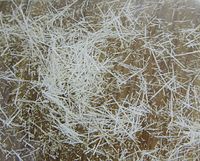Lead(II) azide
 |
|
| Names | |
|---|---|
|
IUPAC name
Diazidolead
|
|
| Identifiers | |
|
3D model (Jmol)
|
|
| ChemSpider | |
| ECHA InfoCard | 100.033.206 |
| EC Number | 236-542-1 |
|
PubChem CID
|
|
| UN number | 0129 |
|
|
|
|
| Properties | |
| Pb(N3)2 | |
| Appearance | White powder |
| Density | 4.71 g/cm3 |
| Melting point | 190 °C (374 °F; 463 K) decomposes, explodes at 350 °C |
| 2.3 g/100 mL (18 °C) 9.0 g/100 mL (70 °C) |
|
| Solubility | Very soluble in acetic acid Insoluble in ammonia solution,NH4OH |
| Thermochemistry | |
|
Std enthalpy of
formation (ΔfH |
462.3 kJ/mol |
| Explosive data | |
| Shock sensitivity | High |
| Friction sensitivity | High |
| Detonation velocity | 5180 m/s |
| Hazards | |
| Main hazards | Harmful, explosive |
| GHS pictograms |
   
|
| GHS signal word | Danger |
| H200, H302, H332, H360, H373, H400, H410 | |
|
EU classification (DSD)
|
|
| R-phrases | R3, R20/22, R33, R50/53, R61, R62, R62 |
| NFPA 704 | |
| 350 °C (662 °F; 623 K) | |
| Related compounds | |
|
Other cations
|
Potassium azide Sodium azide Copper(II) azide |
|
Related compounds
|
Hydrazoic acid |
|
Except where otherwise noted, data are given for materials in their standard state (at 25 °C [77 °F], 100 kPa).
|
|
|
|
|
| Infobox references | |
Lead azide (Pb(N3)2) is an inorganic compound. More so than other azides, Pb(N
3)
2 is explosive. It is used in detonators to initiate secondary explosives. In a commercially usable form, it is a white to buff powder.
Lead azide is prepared by metathesis between sodium azide and lead nitrate. Dextrin can be added to the solution to stabilize the precipitated product. The solid is not very hygroscopic, and water does not reduce its impact sensitivity. It is normally shipped in a dextrinated solution that lowers its sensitivity. When protected from humidity, it is completely stable in storage. An alternative method involves dissolving lead acetate in a sodium azide solution.
Lead azide in its pure form was first prepared by Theodor Curtius in 1891. Due to sensitivity and stability concerns, the dextrinated form of lead azide (MIL-L-3055) was developed in the 1920s and 1930s with large scale production by DuPont Co beginning in 1932. Detonator development during World War II resulted in the need for a form of lead azide with a more brisant output. RD-1333 lead azide (MIL-DTL-46225), a version of lead azide with sodium carboxymethylcellulose as a precipitating agent, was developed to meet that need. The Vietnam War saw an accelerated need for lead azide and it was during this time that Special Purpose Lead Azide (MIL-L-14758) was developed; the US government also began stockpiling lead azide in large quantities. After the Vietnam War, the use of lead azide dramatically decreased. Due to the size of the US stockpile, the manufacture of lead azide in the US ceased completely by the early 1990s. In the 2000s, concerns about the age and stability of stockpiled lead azide led the US government to investigate methods to dispose of its stockpiled lead azide and obtain new manufacturers.
...
Wikipedia

